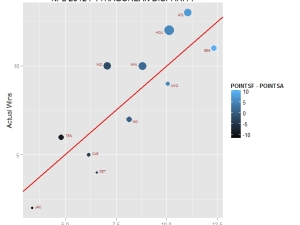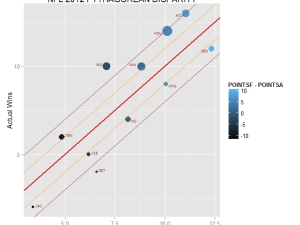September 17, 2015 7:28 PM / 1 Comment on Oracle XE on Windows : Runaway Trace Files

nearly full disk
June 18, 2015 2:07 PM / 3 Comments on What is SQL-Injection?

Warning: Toxic SQL!
GGPLOT2 is a package developed for producing graphics within the R statistical tool. It utilizes a layering metaphor for gradually adding visual details to the desired output. R can support datasets with millions of rows for various aggregation and analysis operations, but it can be slow, unwieldy to code in, and has memory limitations.
This gallery contains 4 photos.
May 2, 2015 8:41 PM / Leave a comment
April 23, 2015 11:24 AM / Leave a comment

Lake Malawi
Often the need arises to locate and remove duplicated rows, or partially duplicated rows from a table. Queries using the DISTINCT keyword (or it’s synonym UNIQUE) will retrieve and display rows without duplicates. But actually identifying and then removing the unwanted duplicates within a table represents a different level of work, and is also likely … Continue reading →
This gallery contains 2 photos.
March 26, 2015 5:19 PM / Leave a comment
March 4, 2015 4:01 PM / Leave a comment
 The premise is as follows: You’ve got useful data lying in an Excel or Google spreadsheet which you’d like translated into relational table(s). This is likely going to involve normalizing the denormalized spreadsheet data on the way into the database; you are going to end up with (and want) more rows in your table than the corresponding quantity within the spreadsheet. The SQL tool for this is the UNPIVOT keyword. Continue…
The premise is as follows: You’ve got useful data lying in an Excel or Google spreadsheet which you’d like translated into relational table(s). This is likely going to involve normalizing the denormalized spreadsheet data on the way into the database; you are going to end up with (and want) more rows in your table than the corresponding quantity within the spreadsheet. The SQL tool for this is the UNPIVOT keyword. Continue…
February 18, 2015 10:23 AM / 1 Comment on Set Operators in SQL

E.F. ‘Ted’ Codd
January 11, 2015 11:19 AM / 2 Comments on More About PIVOT Queries

complex pivot query with both multiple aggregate functions and multiple pivot columns
• Multiple Pivot Columns
• Multiple Aggregate Functions
within the same SQL statement and we’ll see a few errors which commonly arise when building more complex pivot queries like these. Finally, we’ll consider: why would one have a need to UNPIVOT? Continue…
November 6, 2014 6:54 PM / Leave a comment
 In this post, I aim to depict some practical utilizations of assorted Oracle string functions as an antidote to bland, often pointless examples given in SQL documentation. Security and reliable user authentication is ever in the news these days, and many studies confirm that most users continue to choose facile and predictable userids and/or passwords. This article summarizes recent user habits and hacker trends regarding passwords with some basic recommendations, while these two illustrate some of the most common (thus insecure) passwords. Continue…
In this post, I aim to depict some practical utilizations of assorted Oracle string functions as an antidote to bland, often pointless examples given in SQL documentation. Security and reliable user authentication is ever in the news these days, and many studies confirm that most users continue to choose facile and predictable userids and/or passwords. This article summarizes recent user habits and hacker trends regarding passwords with some basic recommendations, while these two illustrate some of the most common (thus insecure) passwords. Continue…
September 3, 2014 10:34 AM / Leave a comment
Back around the era of Oracle 6 or 7, I had an intuition that a certain type of query could be written within the limits of SQL*Plus syntax, but wasn’t quite clear as to how. I was doing some ad-hoc DBA work for a development database once a week or so, and wished to get a handle on who was doing what how frequently in terms of object creation. I envisioned a tabular matrix tallying kinds of objects by user with the aim of watching the changes over time. After doing some legwork exploring the sys.obj$ table and hitting upon using DECODE to trap specific object/user pairs into desired columns, I came up with this: Continue…
 The premise is as follows: You’ve got useful data lying in an Excel or Google spreadsheet which you’d like translated into relational table(s). This is likely going to involve normalizing the denormalized spreadsheet data on the way into the database; you are going to end up with (and want) more rows in your table than the corresponding quantity within the spreadsheet. The SQL tool for this is the UNPIVOT keyword. Continue…
The premise is as follows: You’ve got useful data lying in an Excel or Google spreadsheet which you’d like translated into relational table(s). This is likely going to involve normalizing the denormalized spreadsheet data on the way into the database; you are going to end up with (and want) more rows in your table than the corresponding quantity within the spreadsheet. The SQL tool for this is the UNPIVOT keyword. Continue… In this post, I aim to depict some practical utilizations of assorted Oracle string functions as an antidote to bland, often pointless examples given in SQL documentation. Security and reliable user authentication is ever in the news these days, and many studies confirm that most users continue to choose facile and predictable userids and/or passwords. This article summarizes recent user habits and hacker trends regarding passwords with some basic recommendations, while these two illustrate some of the most common (thus insecure) passwords. Continue…
In this post, I aim to depict some practical utilizations of assorted Oracle string functions as an antidote to bland, often pointless examples given in SQL documentation. Security and reliable user authentication is ever in the news these days, and many studies confirm that most users continue to choose facile and predictable userids and/or passwords. This article summarizes recent user habits and hacker trends regarding passwords with some basic recommendations, while these two illustrate some of the most common (thus insecure) passwords. Continue…










